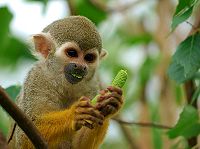Squirrel monkey
| Squirrel monkeys[1] | ||||||||||||||
|---|---|---|---|---|---|---|---|---|---|---|---|---|---|---|
 Common Squirrel Monkey, Saimiri sciureus
| ||||||||||||||
| Scientific classification | ||||||||||||||
| ||||||||||||||
| Simia sciureus Linnaeus, 1758 | ||||||||||||||
|
Saimiri oerstedii |
The squirrel monkeys are the New World monkeys of the genus Saimiri. They are the only genus in the subfamily Saimirinae.
Squirrel monkeys live in the tropical forests of Central and South America. Their range extends from Costa Rica through central Brazil and Bolivia.
Squirrel monkey fur is short and close, colored olive at the shoulders and yellowish orange on its back and extremities. Their throat and the ears are white and their mouths are black. The upper part of their head is hairy. This black and white face gives them their German name, "skull monkeys".
Squirrel monkeys grow to 25 to 35 cm, plus a 35 to 42 cm tail. They weigh 750 to 1100g. Remarkably, the brain mass to body mass ratio for squirrel monkeys is 1:17, which gives them the largest brain, proportionately, of all the primates. Humans have a 1:35 ratio.
Female squirrel monkeys have a pseudo-penis that they use to display dominance over smaller monkeys, much like the way the male squirrel monkeys display their dominance.
Like most of their New World monkey relatives, squirrel monkeys are diurnal and arboreal. Unlike the other New World monkeys, their tail is not used for climbing, but as a kind of "balancing pole" and also as a tool. Their movements in the branches are extremely speedy.
They live together in multi-male/multi-female groups with up to 500 members. These large groups can, however, occasionally break into smaller troops. They have a number of vocal calls, including warning sounds to protect themselves from large falcons, which are a natural threat to them. Their small body size also makes them susceptible to predators such as snakes and felids. For marking territory, squirrel monkeys rub their tail and their skin with their own urine.
Squirrel monkeys are omnivores, eating primarily fruits and insects. Occasionally they also eat nuts, buds, eggs and small vertebrates.
The mating of the squirrel monkeys is subject to seasonal influences. Females give birth to young during the rainy season, after a 150- to 170-day gestation. The mothers exclusively care for the young. Saimiri oerstedti are weaned by 4 months of age, while S. boliviensis are not fully weaned until 18 months old. Female squirrel monkeys reach sexual maturity at age 3 years, while males take until age 5. They live to about 15 years old in the wild, about 20 years in captivity.
The Common Squirrel Monkey S. sciureus is captured for the pet trade and for medical research[2] but it is not endangered. Three squirrel monkey species are in danger of extinction. S. o. oerstedti is listed as "endangered," S. o. citrinellus is listed as "critically endangered" and S. vanzolinii is listed as "Vulnerable."
Classification
- Genus Saimiri
- S. sciureus group
- Central American Squirrel Monkey, Saimiri oerstedii
- Black-crowned Central American Squirrel Monkey, Saimiri oerstedii oerstedii
- Grey-crowned Central American Squirrel Monkey, Saimiri oerstedii citrinellus
- Common Squirrel Monkey, Saimiri sciureus
- Saimiri sciureus sciureus
- Saimiri sciureus albigena
- Humboldt's Squirrel Monkey, Saimiri sciureus cassiquiarensis
- Ecuadorian Squirrel Monkey, Saimiri sciureus macrodon
- Bare-eared Squirrel Monkey, Saimiri ustus
- Central American Squirrel Monkey, Saimiri oerstedii
- S. boliviensis group
- Black-capped Squirrel Monkey, Saimiri boliviensis
- Bolivian Squirrel Monkey, Saimiri boliviensis boliviensis
- Peruvian Squirrel Monkey, Saimiri boliviensis peruviensis
- Black Squirrel Monkey, Saimiri vanzolini
- Black-capped Squirrel Monkey, Saimiri boliviensis
- S. sciureus group
ReferencesISBN links support NWE through referral fees
- ↑ C. Groves, "Order Primates," "Order Monotremata," (and select other orders). Page(s) 138-139 in D. E. Wilson and D. M. Reeder, eds., Mammal Species of the World, 3rd edition, Johns Hopkins University Press (2005). ISBN 0801882214.
- ↑ Rhines, C. (2000). "Saimiri sciureus", Animal Diversity Web. Accessed November 26, 2007
External links
Credits
New World Encyclopedia writers and editors rewrote and completed the Wikipedia article in accordance with New World Encyclopedia standards. This article abides by terms of the Creative Commons CC-by-sa 3.0 License (CC-by-sa), which may be used and disseminated with proper attribution. Credit is due under the terms of this license that can reference both the New World Encyclopedia contributors and the selfless volunteer contributors of the Wikimedia Foundation. To cite this article click here for a list of acceptable citing formats.The history of earlier contributions by wikipedians is accessible to researchers here:
The history of this article since it was imported to New World Encyclopedia:
Note: Some restrictions may apply to use of individual images which are separately licensed.

